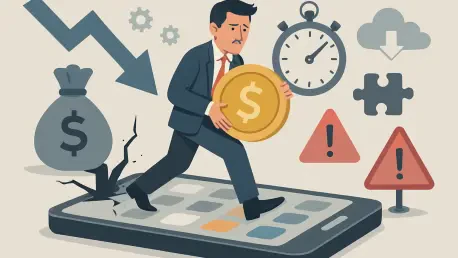In the ever-evolving digital landscape, the mobile app economy stands as a towering pillar of growth, fueled by the ubiquitous presence of smartphones and an insatiable consumer appetite for innovative applications that transform daily interactions. This sector, which spans app sales, in-app advertising, and an array of value-added services, has transformed how businesses and individuals interact in a connected world. Yet, beneath the surface of impressive revenue figures lies a stark reality for many app developers who grapple with financial sustainability. Despite the industry’s expansion, the path to profitability remains fraught with obstacles, from high commission rates to emerging technological shifts. This intricate balance between booming market potential and persistent developer struggles paints a complex picture of an industry at a crossroads, where opportunity and uncertainty coexist.
Growth and Potential in the App Market
Revenue Surge and Future Projections
The mobile app economy has witnessed remarkable growth, with revenues climbing to unprecedented heights over recent years, reflecting the sector’s robust health and consumer demand. Early data from industry analysts like Researc##Guidance highlighted a significant milestone when worldwide smartphone app revenues hit $2.2 billion in just the first half of 2010, surpassing the total of $1.7 billion for the entirety of the previous year. This upward trajectory has only intensified, with forecasts from Juniper Research suggesting that total mobile app-related revenues could reach a staggering $32 billion in the coming years. If the developer community stabilizes at around 100,000 active participants, this could mean an average annual revenue of $320,000 per developer before commissions. Such projections signal a promising economic model, hinting at a future where app development could become a more viable career path for many in the tech space, provided the market dynamics remain favorable.
Diverse Revenue Streams for Developers
Beyond traditional app sales, developers have increasingly turned to alternative monetization strategies to bolster their income in a competitive market. Many create free promotional apps for large corporations, leveraging partnerships to secure steady revenue while building their portfolios. Others adopt the “freemium” model, offering basic app functionalities at no cost while upselling premium features or content to users. In-app advertising also plays a crucial role, providing a consistent income stream even for apps that are free to download. These diverse approaches demonstrate the adaptability of developers in navigating a landscape where direct sales alone often fall short of covering high development costs. While these strategies offer a lifeline, they also underscore the necessity for innovation in revenue generation, as the traditional paid app model faces increasing pressure from both market trends and technological advancements that challenge conventional income structures.
Challenges Threatening Developer Sustainability
Financial Pressures and Profit Margins
Despite the rosy revenue forecasts, the financial reality for individual app developers often tells a more sobering story, marked by tight profit margins and substantial overheads. Back in early 2010, with an estimated 100,000 active developers globally, the average revenue per developer stood at just $22,000 annually, dropping to a mere $15,400 after app store commissions were deducted. Once development costs were factored in, the actual profit dwindled to negligible levels for many. These figures highlight a persistent issue within the industry: while the overall market thrives, the benefits are not evenly distributed. Independent developers, in particular, struggle to achieve financial stability without the backing of larger corporate entities, facing an uphill battle against high operational costs and the need to continuously update and market their apps in an oversaturated digital ecosystem.
Technological Shifts and Market Competition
Adding to the financial strain are technological disruptions that threaten to reshape the very foundation of the mobile app economy, potentially sidelining traditional app store models. The rise of HTML5 technology, which allows sophisticated web apps to run directly in mobile browsers, poses a significant challenge by reducing dependence on downloadable apps. This shift could erode the paid content model that app stores have long supported, as users historically show reluctance to pay for web-based content—a trend seen in the lukewarm reception to paywalls by major media outlets. Furthermore, the growing presence of corporate giants in the app space intensifies competition. Major brands often release free or low-cost apps focused on utility rather than revenue, with only a small percentage designed to generate direct income. This corporate dominance creates downward pressure on pricing, making it increasingly difficult for independent developers to compete on equal footing in a crowded market.
Corporate Dominance and Pricing Pressures
The influence of large corporations in the mobile app arena extends beyond mere competition, actively reshaping market dynamics to the detriment of smaller players. Many big brands develop or sponsor practical apps—think fitness trackers or financial management tools—that prioritize user engagement over profit, with research indicating that only about 12% of corporate apps aim for direct revenue. This strategy not only captures significant market share but also sets a precedent for low or no-cost app offerings, which independent developers find challenging to match without sacrificing their already thin margins. The resulting deflationary effect on app pricing underscores a broader trend where corporate involvement, while beneficial for consumer access, often undermines the economic viability for solo developers or small teams striving to carve out a sustainable niche in this fast-paced industry.
Reflecting on a Dynamic Industry
Lessons from a Competitive Landscape
Looking back, the mobile app economy emerged as a vibrant yet challenging arena, where skyrocketing revenues often masked the struggles faced by individual developers. The stark contrast between industry-wide growth and personal financial instability painted a nuanced picture of success, reminding stakeholders of the need for equitable profit distribution. Historical data revealed how commissions and costs eroded earnings, while corporate influence and technological shifts like HTML5 introduced unforeseen hurdles. These dynamics underscored the fragility of relying solely on traditional app store models, pushing developers to adapt through diverse monetization tactics. Reflecting on this period, it became evident that resilience and innovation were critical for survival in a market defined by rapid change and intense competition, offering valuable insights for navigating similar challenges in other tech sectors.
Charting a Path Forward
As the mobile app economy continues to evolve, addressing the disparities faced by independent developers demands strategic solutions and forward-thinking approaches. Industry leaders could explore reducing app store commission rates to ease financial burdens, while platforms might offer more robust support for small-scale creators through grants or marketing assistance. Developers, on their part, should prioritize diversifying revenue streams—whether through partnerships, freemium models, or targeted advertising—to build resilience against market fluctuations. Additionally, staying ahead of technological trends, such as embracing web app capabilities, could position them to thrive amid disruption. Collaboration between developers, corporations, and platform providers will be essential to foster an ecosystem where innovation is rewarded, and profitability is accessible to all, ensuring that the promise of this dynamic sector translates into sustainable success for every participant.









